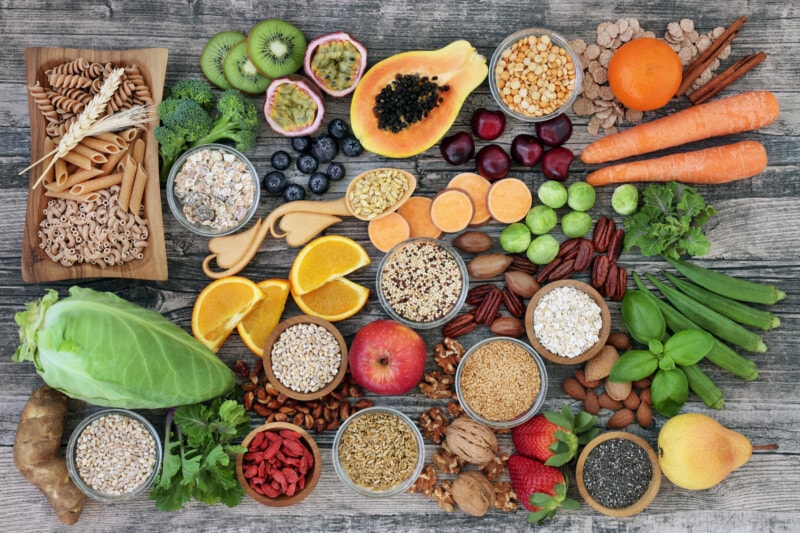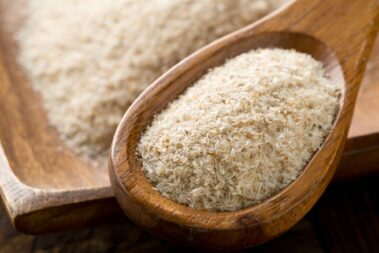It seems like every day there are new diet buzzwords being thrown around by talk show doctors and marketing teams. From keto to paleo to starvation diets, never has the path to a healthier you been more confusing.
You may be tempted to throw “whole food diet” into this diet buzzword bin. But whole food eating is very different from those rule-heavy, restrictive diets popularized by the media. In fact, whole food eating has less to do with rules or more to do with changing how you think about food in general.
In this article, we’ll answer the question, “what are whole foods?,” introduce you to the whole food diet and its many benefits, and give you some simple tips for making whole foods a bigger part of your life.
Table of Contents
What Is Considered a Whole Food?
Whole foods are any type of food that is unprocessed or very minimally processed. Unprocessed foods include things like fresh fruits and vegetables, nuts, seeds, and legumes. Minimally processed foods include grains that have been ground into flour, and food staples with short ingredient lists.
Most things that you could make in your own home, such as bread, pasta, nut butter, and nut milk, fall into the whole foods category.
Whole-food diets can be made up of organic food or conventional, so long as the food is consumed in its natural form or close to it.
Refined grains, refined sugar, and highly processed ingredients like oil are not considered whole foods. Animal products also fall outside the whole food designation.
What Is a Whole Food Diet?
A whole food diet is based primarily on whole, fresh foods and minimally processed ingredients. While it is plant-forward, a whole food diet does not mean following a strict vegan, zero-processed food diet. Instead, it emphasizes whole foods over less healthy alternatives.
The three tenants of a whole food diet are:
- Eat mostly fresh and minimally processed plant-based foods
- Limit animal foods and oils
- Limit refined and processed foods
Notice there are no strict rules here, but rather a simple emphasis on eating plant-based foods in their most pure and nutritious form.

Whole Food vs Vegetarian vs Vegan
Like vegan and vegetarian diets, whole-food diets center around fruits, vegetables, grains, and legumes. But these terms are in no way interchangeable.
People following a whole food diet can eat meat, eggs, and dairy so long as these ingredients do not take center stage. Vegan and vegetarian diets are defined by what they do not include and put no emphasis on eating real food over processed food.
| Food Types | Vegetarian | Vegan | Whole Food |
|---|---|---|---|
| Meat | No | No | Limit |
| Eggs and Dairy | Yes | No | Limit |
| Vegetable Oils | Yes | Yes | Limit |
| Processed Foods | Yes | Yes | Limit |
| Fruits, Veggies, Legumes | Yes | Yes | Yes |
| Whole Grains, Nuts, Seeds | Yes | Yes | Yes |
Of course, it is possible to eat a strictly vegan, whole foods diet. To do this, you simply need to abstain from meat, eggs, and dairy products while emphasizing unprocessed and minimally processed plant-based foods. This type of diet dramatically increases the health benefits that come from eating whole foods.
Benefits of Eating Whole Foods
There are a lot of great reasons to choose whole foods over other options. These include a long list of health benefits to you and to the planet.
Whole Foods Are Nutrient Dense
It’s no secret that fruits, veggies, grains, and legumes are loaded with vitamins and minerals. What people often ignore is the fact that these nutrients are at their most potent when that food is in its whole form.
The moment you cut an apple, it begins to oxidize, a process that reduces its nutritional value. This nutrient loss is exaggerated greatly when foods are exposed to heat and refining agents, two things common in food processing.
By avoiding highly processed foods, you get the most nutrients per calorie consumed. In addition to vitamins and minerals, fresh, whole foods are packed with enzymes to help your body break down and use those nutrients, antioxidants to fight free radicals in your body, and fiber, which is necessary for maintaining a healthy gut biome.
Whole Foods Are Lower In Calories
Calorie for calorie, you’re going to get more nutrition from minimally processed, unrefined food compared to highly processed foods. And, in many cases, the highly processed version will have more calories per serving.
This is often the case because foods typically lose flavor during processing, which means more flavor must be added back in at the end. The cheapest way to do this is to add artificial ingredients, oil, and sugar—three things brimming with empty calories and known to create free radicals in the body.
Whole Foods Take More Calories to Digest
Your body spends about 5 to 10% of its energy digesting and absorbing the nutrients from your food(1). While zero-net-calorie foods (foods that burn more calories during digestion than they provide) don’t really exist, there are plenty of foods that provide way more calories than what your body expends to process them.
Refined grains, refined sugar, and oils are some of the easiest foods for the body to digest. Because they don’t contain any fiber, they are also some of the most calorie-dense options.
Whole foods, on the other hand, often contain a high amount of fiber and nutrients, meaning your body has to expend more calories to digest them. Additionally, some of the calories in structurally intact plant foods are unavailable to the human body and can only be broken down and used by the flora in your gut. Both of these reasons contribute to the fact that a whole food diet is the only non-restrictive, non-exercise-based diet type to consistently help people lose weight(2).
Whole Foods Fight Disease
There have been numerous studies on the health benefits of whole, plant-based food diets.
Dr. Neal Barnard, who has been studying the link between diet and cardio-metabolic diseases for decades, has found that a whole-food, plant-based diet can reduce a person’s risk of coronary heart disease events by 40%, their risk of cerebral vascular disease by 29%, and cut their risk of developing metabolic disease and type 2 diabetes by half(3).
Additional studies have shown that a whole food diet can improve outcomes for people suffering from a wide range of health issues and chronic diseases, including polycystic ovary disease, angina, and kidney disease(4)(5)(6). Whole food diets have even been shown to remove harmful carcinogens and gerontotoxins from the bloodstream and lengthen telomeres, thereby preventing cellular damage and reducing signs of aging(7).
Find What You Need in Nature
Whole foods have been minimally processed, if at all, meaning that you’re eating them in their most natural state. Nature has a way of providing what we need most, including when it comes to health-protective foods.
A diet based on whole plants, including fruits, vegetables, grains, nuts, seeds, and legumes, is naturally rich in essential vitamins and minerals, fiber, antioxidants, and other plant compounds that help support a normal inflammatory response. On the other hand, diets high in ultra-processed and packaged foods, added sugar, and sodium are known to promote inflammation.
As systemic inflammation is underlying in numerous western diseases, keeping it at bay as much as possible with a whole food diet is an important preventive health practice.
Whole Foods Support a Healthier Planet
Eating a whole, plant-based food diet isn’t just good for you. This approach to food is also better for the planet.
Animal agriculture is responsible for more greenhouse gas emissions than the entire transportation sector(8). Fifty-five percent of water used in the US is used for animal agriculture, a practice that occupies over ⅓ of the world’s ice-free land(9). Raising animals for food is the number one cause of species extinction, habitat destruction, and ocean dead zones(10).
All this is to say, the best choice you can make for the planet is to limit your meat, dairy, and egg consumption.
In addition to reducing the demand for animal agriculture, a whole food diet also reduces resource consumption. Unprocessed and minimally processed foods require less water, energy, and packaging, and produce less pollution than their highly processed counterparts.

How to Include More Whole Foods In Your Diet
There are a lot of great reasons to eat more whole plant foods. If you want to change up your diet to be more whole-food-centric, there are a few simple things you can do to make the transition as easy as possible.
- Replace refined grains with whole grains at mealtime. Swap out your white rice for brown rice, your white bread for whole wheat, and your white pasta for wheat.
- Add more vegetables to your plate. One simple way to do this is to add a side of steamed fresh vegetables to every dinner.
- Replace snack foods with whole fruits, vegetables, and nuts. Instead of reaching for the chips, try slicing up an apple with some nut butter. Not only are snacks like oranges, berries, almonds, pumpkin seeds, carrots, and celery better for you, but they also produce less trash since they don’t require a lot of packaging.
- Make more meals from scratch. Even the healthiest prepackaged meals are more processed than those you make from scratch at home. Cooking your own food also gives you more control of the type and quality of ingredients you use.
- Make your own staples. There are plenty of vegan alternatives available at grocery stores these days. But they’re often highly processed and made with refined ingredients. You can make many of these staples at home using whole-food ingredients. Some of our favorites include homemade vegan mayo, ketchup, and almond milk.
- Add whole-food flavor. If you’re used to eating a lot of processed food, it will take some time to get used to the more subtle natural flavors of unprocessed food. You can help ease this transition by adding extra spices and whole-food flavorings like nutritional yeast.
- Reduce your oil use. Whether added to food directly or used in cooking, reducing your oil intake is often the hardest part of following a whole-food diet. Start by skipping added butter and oil and try using less in the pan. Look into cooking methods and kitchen tools that allow you to cook without any added oils.
The transition to a whole food diet is one of the easier diet changes to make, especially if you are already following a vegetarian or vegan diet. But the key to success is to move at your own pace and remember that this way of eating is based on emphasizing and limiting, not on specific focuses and strict exclusions.
- How to Pick the Perfect Watermelon For a Sweet Summer Treat - April 10, 2024
- Future Kind’s Foundations: A Multivitamin Made for Vegans - December 5, 2023
- Does Nutritional Yeast Go Bad? - November 28, 2023







